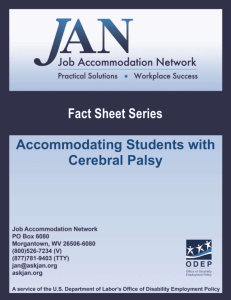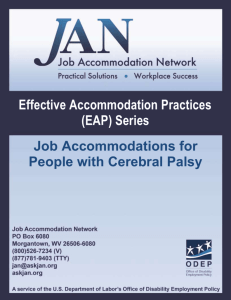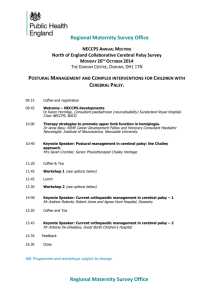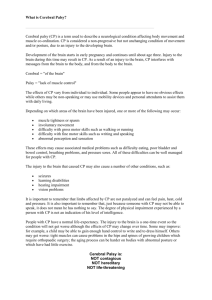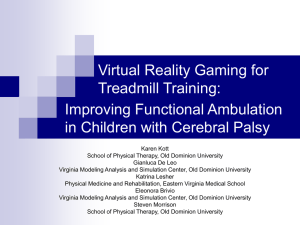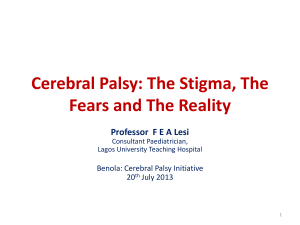Cerebral Palsy
advertisement
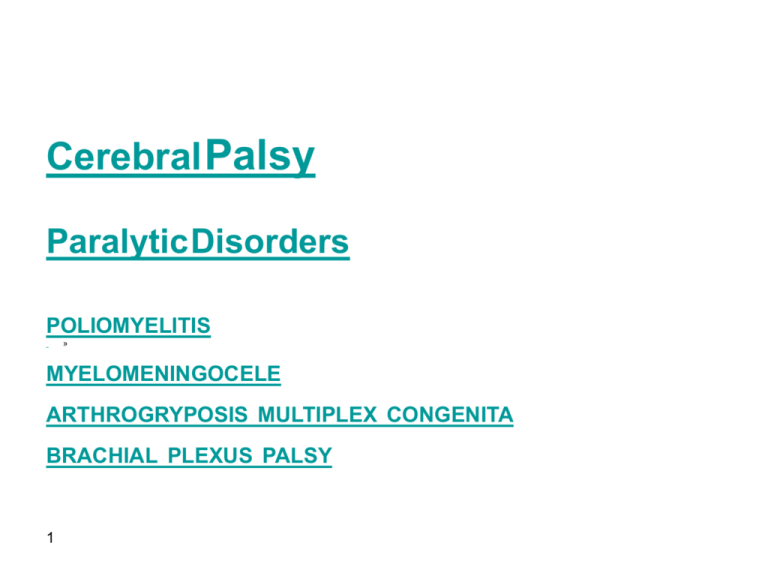
Cerebral Palsy ParalyticDisorders POLIOMYELITIS » MYELOMENINGOCELE ARTHROGRYPOSIS MULTIPLEX CONGENITA BRACHIAL PLEXUS PALSY 1 Cerebral Palsy 2 ETIOLOGY (1) Some degree of motor impairment is present (2) an insult to the developing brain has occurred (3) a neurological deficit is present that is nonprogressive 3 The insult to the brain is believed to occur between the time of conception and age 2 years, at which time a significant amount of motor development has already occurred. 4 neurological deficit is Permanent Nonprogressive . 5 PREVALENCE: amount and quality of prenatal care, the socioeconomic condition of the parents, the environment, obstetrical and pediatric care the mother and child receive. prevalence = 0.6 to 7cases per 1000 live births 6 prenatal, perinatal, postnatal. Contrary to popular belief, fewer than 10% of injuries that result in cerebral palsy occur during the birth process. 7 prenatal fetus (most commonly genetic disorders), mother (seizure disorders, mental retardation, and previous pregnancy loss), pregnancy itself (Rh incompatibility, polyhydramnios, placental rupture, and drug or alcohol exposure). External factors, such as TORCH (toxoplasmosis, other agents, rubella, cytomegalovirus, herpes simplex). 8 perinatal asphyxia or trauma that occurs during labor. Oxytocin augmentation, umbilical cord prolapse breech presentation. Low-birth-weight infants (<1500 g) incidence of 60 per 1000 births compared with two per 1000 births in normal-weight infants. periventricular blood vessels. Pregnancies involving multiple births 9 white matter 10 postnatal Hypoxic-ischemic encephalopathy, persistent fetal circulation with true ischemia meconium aspiration which is characterized by hypotonia, decreased movement, and seizures Infections such as encephalitis and meningitis Traumatic brain injury 11 12 Geographical Classification 13 Monoplegia very rare usually occurs after meningitis. Most patients diagnosed with monoplegia actually have hemiplegia 14 Diplegia most common 50% premature infants intelligence normal Most children with diplegia walk eventually although walking is delayed usually until around age 15 4 years Hemiplegia 30%, typically have sensory changes Hemiplegic patients also may have a leg-length discrepancy 16 Quadriplegia significant cognitive deficiencies that make care more difficult. Head and neck control which helps with communication, education, and seating. Treatment goals straight spine level pelvis, 17 located mobile hips, plantigrade feet that.. Total Body profound cognitive deficits head and neck control. full-time assistance for activities of daily living and specialized seating systems to assist with head positioning. Drooling, dysarthria, and dysphagia 18 Paraplegia is very rare triplegia 19 20 Physiological Classification 21 22 different pathways of the brain are myelinated at different times, spastic diplegia 8 to 10 months of age; hemiplegia, 20 months of age athetoid cerebral palsy, after 24 months of age. 23 24 DIAGNOSIS History and physical examination are the primary… spastic paraparesis and congenital ataxia. Ancillary studies, such as radiographs, hematological studies, . Diagnosis of cerebral palsy before age 2 years can be very difficult. Transient dystonia of prematurity is a condition characterized by increased tone in the lower extremities between 4 and 14 months old and often is confused with cerebral palsy. 25 DIAGNOSIS Knowledge of normal motor developmental milestones and primitive reflexes allows identification of children who are delayed in their motor development. Motor development usually occurs in a cephalad-to-caudal pattern, starting with swallowing and sucking, which are present at birth, and proceeding to sphincter control, which occurs at 24 to 36 months of age. Primitive reflex patterns of motor activity that are outgrown as part of the normal maturation process persist longer than normal and in some cases permanently in children with cerebral palsy. Neurological quotient can be determined, which is useful in determining prognosis and treatment. 26 Prognostic Factors If a child has not learned to walk by age 8 years, and he or she is not limited by severe contractures, it is unlikely he or she will ever walk at all. sitting independently before age 2 years was not a good predictor of ultimate ambulatory ability, but the inability to sit independently by 4 years predicted nonambulation Bleck used the presence or absence of primitive reflexes to determine prognosis for ambulation for children with cerebral palsy 27 28 ASSOCIATED CONDITIONS In one study, adults with cerebral palsy ranked what was most important to them: education and communication activities of daily living Mobility Ambulation Because of the often complex nature of these conditions, a multidisciplinary team approach to patients with cerebral palsy is essential. 29 ASSOCIATED CONDITIONS mental impairment or learning disability (40%); seizures (30%); complex movement disorders (20%); visual impairment (16%); malnutrition and related conditions (15%) hydrocephalus (14%). Bulbar involvement can lead to drooling, dysphagia, and speech difficulties, which can limit cognitive and social development further. Many children with cerebral palsy (50% in some series) have significant visual difficulties, with 7% having a severe visual defect. Common visual disturbances include myopia, amblyopia, strabismus, visual field defects, and cortical blindness. Hearing loss has been reported to occur in 10% to 25% of children with cerebral palsy, which can exacerbate communication and learning difficulties further. Hearing screenings, similar to visual screenings, should be part of the routine evaluation of patients with cerebral palsy. 30 ASSOCIATED CONDITIONS Seizures(30%), most commonly patients with : hemiplegia, quadriplegia, postnatally acquired syndromes. Osteopenia with increased risk of fracture also is common in children with cerebral palsy, especially children who are more severely affected. The nonoperative and operative treatment of these fractures Bisphosphonates have been shown in small studies 31 ASSOCIATED CONDITIONS Severe medical problems, such as aspiration pneumonia and profound feeding problems, can lead to malnutrition, immune suppression, and metabolic abnormalities. Gastroesophageal reflux often can be managed medically and with positioning, but fundoplication may be necessary. Enteral feeding augmentation often is necessary because of swallowing dysfunction and the risk of aspiration pneumonia. This can be done with a gastrostomy or jejunostomy tube. Emotional problems add to these associated conditions. The child's self-image plays an important role, especially in adolescence, when the differences between the affected child and peers become more apparent. Communication difficulties also may affect self-image at this stage. As young adulthood is reached, concerns about employment, self-care, sexual function, marriage, childbearing, and caring for aging parents may become emotional stressors. 32 TREATMENT a multidisciplinary team approach Four basic treatment principles exist. 1- cp is nonprogressive, the deformities are progressive. 2-treatments currently available correct the secondary deformities only and not the primary problem. 3-deformities typically become worse during times of rapid growth. 4-operative or nonoperative treatment should be done to minimize the impact it has on the patient's socialization and education. 33 TREATMENT Nonoperative splinting and bracing physical therapy, most common agents =diazepam and baclofen, which act centrally, dantrolene, which acts at the level of skeletal muscle. Baclofen mimics the action of g-aminobutyric acid, a powerful inhibitory neurotransmitter centrally and peripherally, whereas diazepam potentiates the activity of g-aminobutyric acid. Dantrolene acts at the level of skeletal muscle develop profound weakness, hepatotoxicity New trend intrathecal baclofen and intramuscular botulinum toxin injections 34 TREATMENT 35 TREATMENT Botulinum toxin a potent neurotoxin, of which there are seven serotypes, produced by ..Clostridium botulinum Contraindications BTX-A therapy include known resistance or antibodies, fixed deformity or contracture, concurrent use of aminoglycoside antibiotics, failure of previous response, and certain neurological conditions such as myasthenia gravis 36 TREATMENT Physical therapy The therapist plays a crucial role in all aspects of care, including identifying children who may have cerebral palsy, treating their spasticity and contractures, fabricating splints and simple braces, providing family education and follow-up, acting as a liaison with the school and other health care providers, and implementing home stretching and exercise programs with the patients and their families. Bracing, The most commonly used braces for the treatment of cerebral palsy include ankle-foot orthoses, hip abduction braces, hand and wrist splints, and spinal braces or jackets. A patient-centered approach should be used. The goals of bracing for an ambulatory child differ from the goals for a child with severe involvement. Bracing of the lower extremities, most commonly with ankle-foot orthoses, is common in patients with cerebral palsy. 37 TREATMENT Operative (1) correct static or dynamic deformity, (2) balance muscle power across a joint (3) reduce spasticity (neurectomy), and (4) stabilize uncontrollable joints. Often, procedures can be combined—an adductor tendon release can be done at the time of pelvic osteotomy for hip subluxation .38 TREATMENT 39 TREATMENT HIP In patients with cerebral palsy, all hips should be considered abnormal until proved otherwise Deformities of the hip in patients with cerebral palsy range from mild painless subluxation to complete dislocation with joint destruction, pain, and impaired mobility. prevalence of hip pain in 234 patients (mean age 28 years old) was 47% It has been estimated that progressive hip instability occurs in approximately 15%. commonly severely affected patients and patients with spastic quadriplegia 40 41 TREATMENT KNEE Hip and Knee Relationships Pelvic, hip, knee, ankle, and foot deformities are interrelate because of the muscles that cross both joints, the “two-joint muscles.” Flexion is the most common knee deformity in patients with cerebral palsy and frequently occurs in ambulatory children. 42 43 44 POLIOMYELITIS 45 POLIOMYELITIS 46 POLIOMYELITIS a viral infection localized in the anterior horn cells of the spinal cord and certain brainstem motor nuclei. One of three 47 types of poliomyelitis viruses poliomyelitis vaccine, the incidence of acute anterior poliomyelitis in the Western world has decreased dramatically. Live oral poliovirus vaccine (OPV) Inactivated poliovirus vaccine (IPV) OPV remains the vaccine of choice for global eradication in many parts of the world, specifically 48 Pathological Findings When the poliomyelitis virus invades the body through the oropharyngeal route, it multiplies…. The incubation period is 6 to 20 days. . 49 The anterior horn motor cells may be damaged directly by viral multiplication or toxic byproducts of the virus or indirectly by ischemia, edema, and hemorrhage in the glial tissues surrounding them. 50 51 Destruction of the spinal cord occurs focally, and within 3 days, wallerian degeneration is evident throughout the length of the individual nerve fiber. Macrophages and neutrophils surround and partially remove necrotic ganglion cells, and the inflammatory response gradually subsides. 52 After 4 months, residual areas of gliosis and lymphocytic cells fill the area of destroyed motor cells in the spine. Reparative neuroglial cells proliferate. 53 Continuous disease activity has been reported in spinal cord segments 20 years after onset of the disease 54 The number of individual muscles affected by the resultant flaccid paralysis and the severity of paralysis vary; the clinical weakness is proportional to the number of lost motor units. weakness is clinically detectable only when more than 60% of the nerve cells supplying the muscle have been destroyed. 55 Muscles innervated by the cervical and lumbar spinal segments are most often affected paralysis occurs twice as often in the lower extremity muscles as in upper extremity muscles. 56 lower extremity quadriceps, glutei, anterior tibial, medial hamstrings, and hip flexors upper extremity the deltoid, triceps, and pectoralis major 57 58 recovery of muscle function depends on the recovery of damaged, but not destroyed, anterior horn cells. first month almost complete within 6 months, although limited recovery may occur for about 2 years 59 Clinical Course and Treatment acute convalescent chronic 60 Acute Stage lasts 7 to 10 days Symptoms range from mild malaise to generalized encephalomyelitis with widespread paralysis. In younger children, systemic symptoms include listlessness, sore throat, and a slight temperature elevation; these may resolve, but recurrent symptoms, including hyperesthesia or paresthesia in the extremities, severe headache, sore throat, vomiting, nuchal rigidity, back pain, and limitation of straight leg raising, culminate in characteristically asymmetrical paralysis. 61 Acute Stage In older children and adults, symptoms slight temperature elevation marked flushing of the skin apprehension muscular pain is common. Muscles are tender even to gentle palpation. Superficial reflexes usually are absent first, and deep tendon reflexes disappear when the muscle group is paralyzed. 62 Acute Stage Differential diagnoses include Guillain-Barré syndrome other forms of encephalomyelitis. 63 Acute Stage Treatment bed rest, analgesics, hot packs, and anatomical positioning of the limbs to prevent flexion posturing and contractures. Padded foot boards, pillows, sandbags, and slings can help maintain position. Gentle, passive range-of-motion exercises of all joints should be carried out several times each day 64 Convalescent Stage begins 2 days after the temperature returns to normal and continues for 2 years. Muscle power improves spontaneously during this stage, especially during the first 4 months and more gradually thereafter. 65 Convalescent Stage Treatment is similar to that during the acute stage. Muscle strength should be assessed monthly for 6 months and then every 3 months. Physical therapy Muscles with more than 80% return of strength recover spontaneously without specific therapy. 66 Convalescent Stage Vigorous passive stretching exercises and wedging casts can be used for mild or moderate contractures. Surgical release of tight fascia and muscle aponeuroses and lengthening of tendons may be necessary for contractures persisting longer than 6 months. Orthoses should be used until no further recovery is anticipated. 67 Chronic Stage The chronic stage of poliomyelitis usually begins 24 months after the acute illness. 68 Chronic Stage treatment goals correcting any significant muscle imbalances and preventing or correcting soft-tissue or bony deformities. Static joint instability usually can be controlled indefinitely by orthoses. Dynamic joint instability eventually results in a fixed deformity that cannot be controlled with orthoses. 69 Chronic Stage Young children are more prone to develop bony deformity than are adults because of their growth potential. Soft-tissue surgery, such as tendon transfers, should be done in young children before the development of any fixed bony changes; bony procedures for correcting a deformity usually can be delayed until skeletal growth is near completion. 70 71 http://www.mdconsult.com/das/book/ body/114738354-4/ 72

